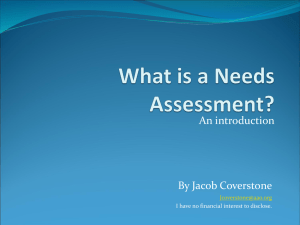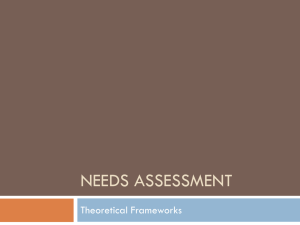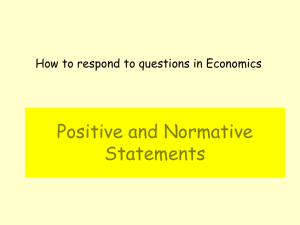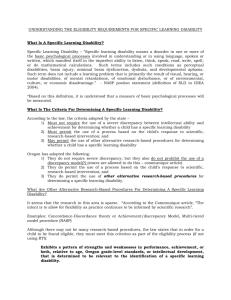Comparing Sample Mean & Variance to Normative Data in SPSS
advertisement
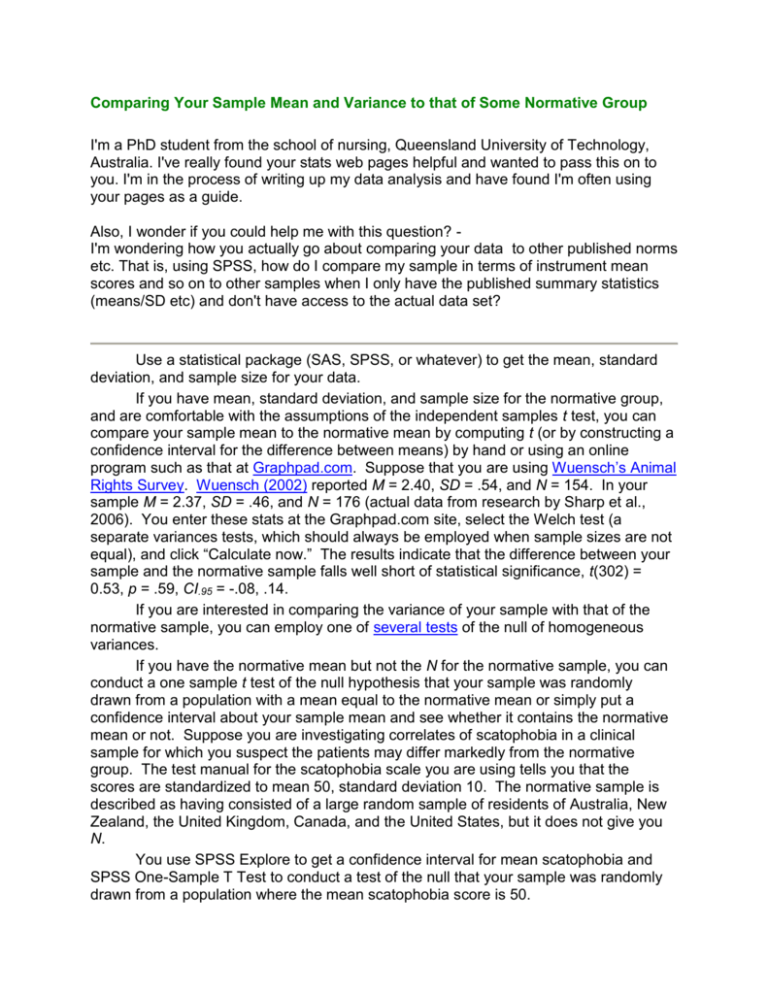
Comparing Your Sample Mean and Variance to that of Some Normative Group I'm a PhD student from the school of nursing, Queensland University of Technology, Australia. I've really found your stats web pages helpful and wanted to pass this on to you. I'm in the process of writing up my data analysis and have found I'm often using your pages as a guide. Also, I wonder if you could help me with this question? I'm wondering how you actually go about comparing your data to other published norms etc. That is, using SPSS, how do I compare my sample in terms of instrument mean scores and so on to other samples when I only have the published summary statistics (means/SD etc) and don't have access to the actual data set? Use a statistical package (SAS, SPSS, or whatever) to get the mean, standard deviation, and sample size for your data. If you have mean, standard deviation, and sample size for the normative group, and are comfortable with the assumptions of the independent samples t test, you can compare your sample mean to the normative mean by computing t (or by constructing a confidence interval for the difference between means) by hand or using an online program such as that at Graphpad.com. Suppose that you are using Wuensch’s Animal Rights Survey. Wuensch (2002) reported M = 2.40, SD = .54, and N = 154. In your sample M = 2.37, SD = .46, and N = 176 (actual data from research by Sharp et al., 2006). You enter these stats at the Graphpad.com site, select the Welch test (a separate variances tests, which should always be employed when sample sizes are not equal), and click “Calculate now.” The results indicate that the difference between your sample and the normative sample falls well short of statistical significance, t(302) = 0.53, p = .59, CI.95 = -.08, .14. If you are interested in comparing the variance of your sample with that of the normative sample, you can employ one of several tests of the null of homogeneous variances. If you have the normative mean but not the N for the normative sample, you can conduct a one sample t test of the null hypothesis that your sample was randomly drawn from a population with a mean equal to the normative mean or simply put a confidence interval about your sample mean and see whether it contains the normative mean or not. Suppose you are investigating correlates of scatophobia in a clinical sample for which you suspect the patients may differ markedly from the normative group. The test manual for the scatophobia scale you are using tells you that the scores are standardized to mean 50, standard deviation 10. The normative sample is described as having consisted of a large random sample of residents of Australia, New Zealand, the United Kingdom, Canada, and the United States, but it does not give you N. You use SPSS Explore to get a confidence interval for mean scatophobia and SPSS One-Sample T Test to conduct a test of the null that your sample was randomly drawn from a population where the mean scatophobia score is 50. Descriptives Scatopho Mean 95% Confidence Interval for Mean Statistic 54.472 52.609 Lower Bound Upper Bound Std. Error .9283 56.335 As you can see above, the confidence interval for your sample does not include the normative mean, so you can report that mean scatophobia in your sample is significantly greater than that in the normative group. One-Sample Statistics N Scatopho Mean 53 Std. Deviation 54.472 Std. Error Mean 6.7585 .9283 One-Sample Test Test Value = 50 95% Confidence Interval of the Difference t Scatopho 4.817 df Sig. (2-tailed) 52 .000 Mean Difference 4.4717 Lower 2.609 Upper 6.335 Here SPSS has given you more statistics that may chose to use to describe how your sample differs from the normative group. It is probably more important to report by how much your sample differs from the normative group than whether the difference is significant or not. With very large samples even trivial differences will be significant, and with small samples even large differences will not be significant. Where the unit of measure is not intrinsically meaningful, it should be helpful to report how large the difference is in standard deviation units. For the example above your sample has a mean 4.472 points above that of the normative group. How large is that in standard deviation units? For this case, that depends on whether you use your sample standard deviation or the normative standard deviation. In this case I think it makes more sense to use the normative standard deviation, which is 10. Your sample has a mean .45 standard deviations greater than that of the normative group. This statistic, by the way, is known as Glass’ delta. You should also note that your sample had a standard deviation lower than that in the normative group. You could test the null that your sample was randomly drawn from population where the standard deviation is the same as it is in the normative group (10), but such hypotheses are rarely tested. Alternatively, you could report a confidence interval for the sample standard deviation. Graphpad has an online program that will do that for you. For our sample Graphpad calculates a 95% confidence interval that runs from 5.67 to 8.36. Note that this does not include the normative value (10). The scatophobia scores in our sample are significantly less variable than in the normative group. Reference Sharp, H. W., Wuensch, K. L., Eppler, M. A., & Harju, B. L. (2006, April). Narcissism, empathy, and attitudes towards animals. Presented at the Spring Conference of the North Carolina Psychological Association and North Carolina Psychological Foundation, Charlotte, NC. Return to Wuensch’s Stat Help Page

